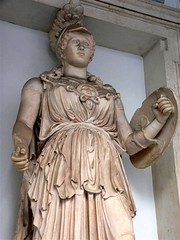
Researchers have tried to bring back to life the city's food chain by replanting, in the restaurant's garden and in other open spaces throughout the city's ruins, the fruits and vegetables that were part of the Roman diet -- figs and olives, plums and grapes, as well as broom, bramble, poppy and mallow.
Kits with the ingredients will be sold to visitors in the area around the restaurant with instructions on how to cook their own Roman specialties. Although there will be no cooking on the site, visitors will be directed to a local restaurant where some of the specialties will be offered.
"We wanted to learn what the inhabitants of Pompeii ate,'' said Anna Maria Ciarallo, a biologist who heads the project for Pompeii's archaeological office. "But we wanted a side of the project to appeal directly to the public as well.''
Some may keep away from "garum,'' a pungent sauce used for flavoring and obtained by fermenting fish entrails, but Ciarallo said that many Roman dishes closely resembled modern cuisine.
The recipe to make prosciutto ham has remained unchanged, while "savillum,'' the favorite dessert of many Romans, was a baked cream similar to today's custard, Ciarallo said.
Pompeii's rich were known to feast on such exotic dishes as swallow's tongue and parrot meat, but the project is presenting more everyday fare, Ciarallo said.
The restaurant was located between the gymnasium, the amphitheater and one of the city's gates and mostly catered to middle-class merchants and travelers, Ciarallo said.
Its six benches were probably always filled with hungry customers passing through the busy neighborhood, she said. The guests would recline on one side on the benches, as eating customs demanded at the time, to chat, play dice -- one of the Romans' favorite pastimes -- and partake of the dishes served out of large pots. The quiche-like "libum'' is made with bread, laurel leaves and cheese resembling today's ricotta.
"It was a sweet and sour cuisine, which blended the sharp tastes of vinegar and spices with the sugars of honey and figs,'' Ciarallo said. Cereals and beans were the staples of the Roman diet, together with fish, cheese and limited quantities of eggs and meat.
| | ||||
|
"The main differences were between the social classes,'' she said.
Slaves were kept on a high-energy diet of bread, dried-fruits and low quality cheese and wine. The upper classes enjoyed the same foods available to the middle class, but the quantities were larger, the ingredients finer, and the banquets were lavish presentations.
The project will shut down on June 26 because of lack of funds...Some recipes prepared in ancient Pompeii:
Peaches with Cumin
Can be an appetizer or a dessert.
![]() Peel and chop up some firm peaches
Peel and chop up some firm peaches
![]() Cover peaches in a cumin sauce made with ground pepper, parsley, mint leaves, cumin, honey, vinegar and a dash of garum, which is a fish sauce made from fish entrails steeped in brine. A modern-day version of garum, "colatura di alici'' or anchovy juice, is still produced on the Amalfi coast.
Cover peaches in a cumin sauce made with ground pepper, parsley, mint leaves, cumin, honey, vinegar and a dash of garum, which is a fish sauce made from fish entrails steeped in brine. A modern-day version of garum, "colatura di alici'' or anchovy juice, is still produced on the Amalfi coast.
Celery Dessert
![]() Chop celery, roast the pieces in an oven.
Chop celery, roast the pieces in an oven.
![]() Serve with honey and ground pepper.
Serve with honey and ground pepper.
Pork with Dried Figs and Cheese Side Dish
![]() Boil a fresh pork shoulder with dried figs and bay leaves.
Boil a fresh pork shoulder with dried figs and bay leaves.
![]() Carve off the rind, cover in pastry and bake in a hot oven.
Carve off the rind, cover in pastry and bake in a hot oven.
![]() For side dish, mix different types of herbs into fresh ricotta-like cheese, add some olive oil and serve with sesame seeds or hazelnuts.
For side dish, mix different types of herbs into fresh ricotta-like cheese, add some olive oil and serve with sesame seeds or hazelnuts.
-- Associated Press


